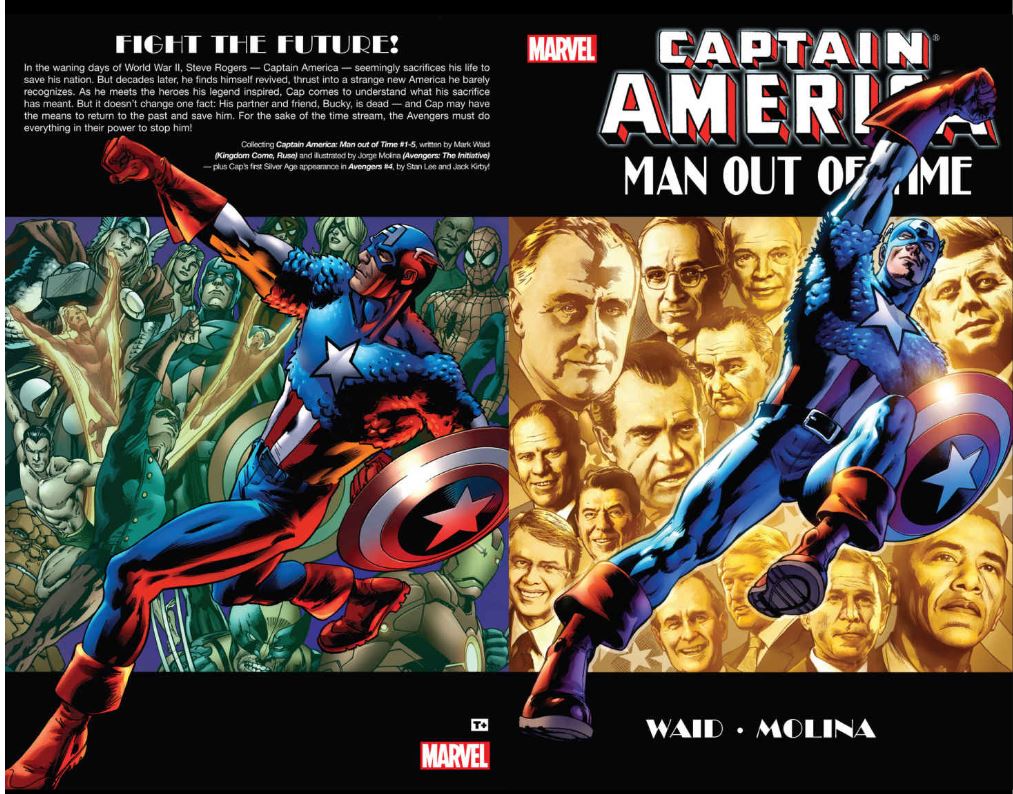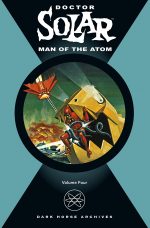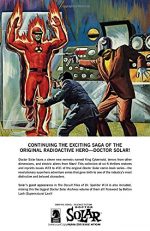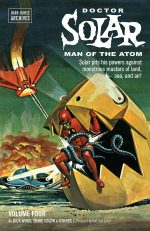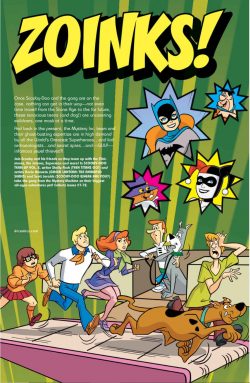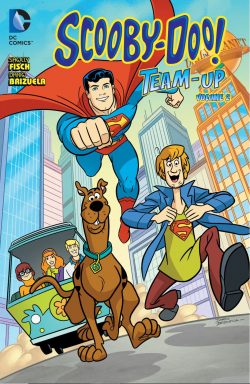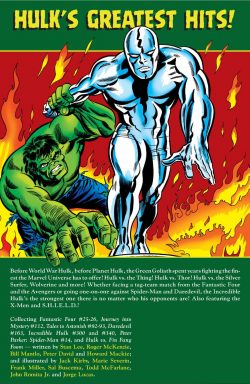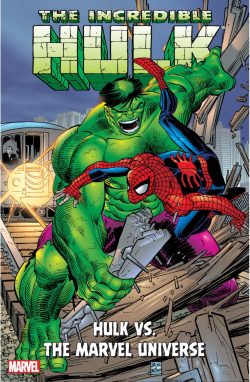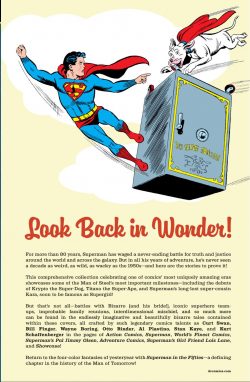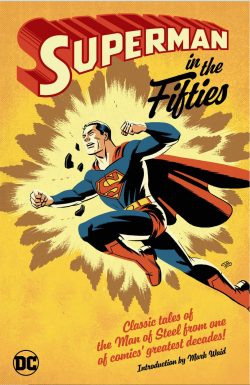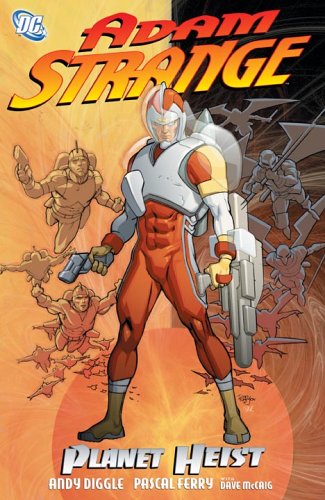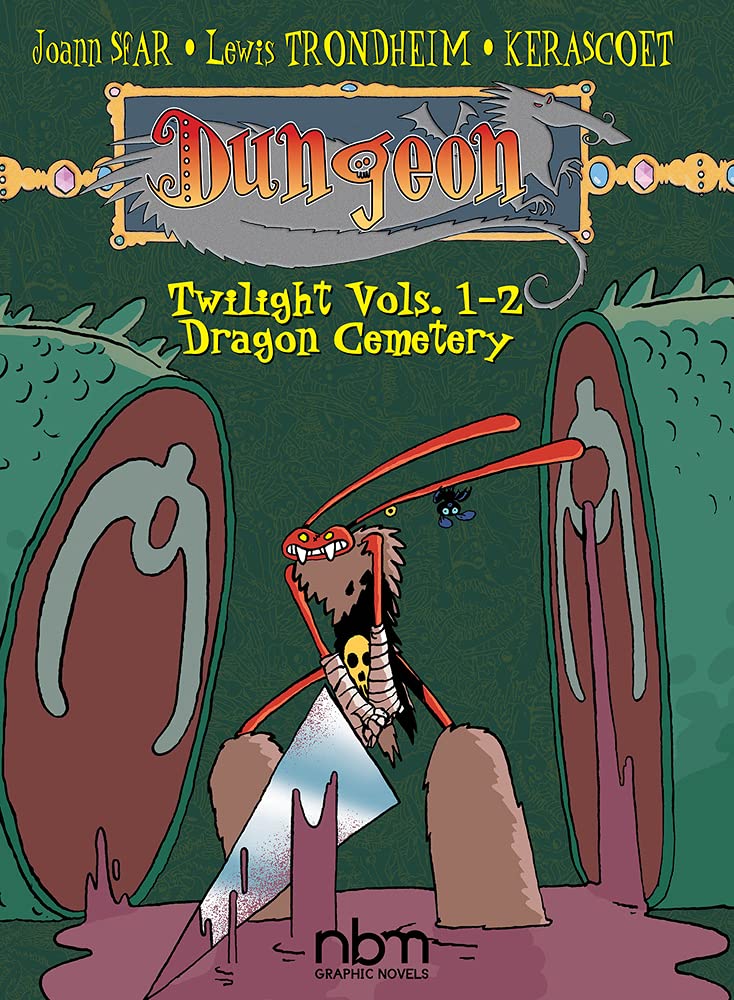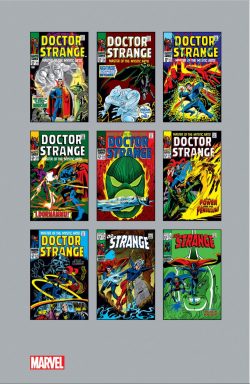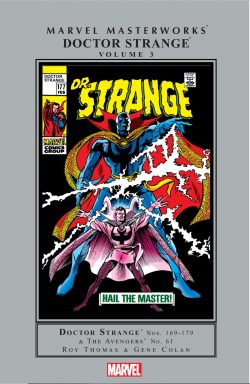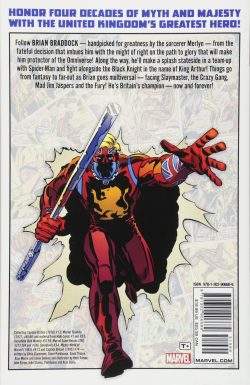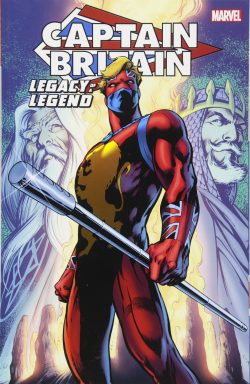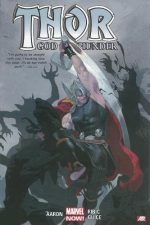
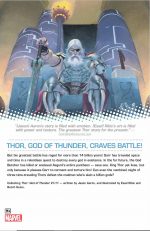
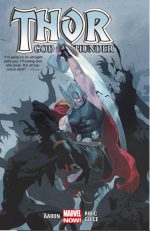
By Jason Aaron, Esad Ribic, Butch Guice, Tom Palmer & various (MARVEL)
ISBN: 978-0785191131 (HB/Digital edition)
In the wake of the game-changing Avengers versus X-Men publishing event, the company’s entire continuity was reconfigured. From that point on, the proud banner MarvelNOW! indicated a radical repositioning and recasting of all the characters in an undertaking designed to keep the more than 50-year old universe interesting to readers old and new alike.
This involved a varying degree of drastic rethink for beloved icons, concepts and brands, always, I’m sure, with one wary eye on how the material would look on a movie screen…
Well the fourth Thor feature film is upon us and this collection will offer the print origins of its major villain, so buckle up for a rocky rowdy ride…
Collecting Thor, God of Thunder #1-11 (cover-dated January-October 2013), this big, bold blockbuster saga simultaneously unfolds over three separate eras, offering a spectacular clash as the bellicose Lord of Lightning faces his ultimate adversary…
It begins in 893AD where a young god revels amongst his Viking worshippers in Iceland, slaying monsters and bedding mortal maids in the days before he proved worthy enough to wield mystic mallet Mjolnir.
During his revels a dismembered corpse washes up, terrifying the valiant Norsemen. They have never seen the like, but Thor recognises it as a god from another pantheon, slaughtered and dismembered like meat…
In the now, Thor is summoned into deep space and the parched planet Indigarr. The Storm Lord has mystically heard the desperate prayer of a little girl and on his arrival brings rain and salvation to her dying world. Celebrated as a saviour, the Thunderer wonders aloud why the people did not pray to their own gods – across the entire universe, all civilisations and peoples have deities – and learns they are dead.
Investigating further, he locates Indigarr’s god-palace and discovers the entire pantheon was tortured to death eons ago and as a monstrous black beast ambushes him, he remembers a horrific experience more than a millennium past and knows fear…
In the furthest future, an aged Thor sits in a shattered Great Hall of Asgard. He has only one arm and one eye and is the last god – perhaps the last being – in existence …except for the uncountable hordes of savage black beasts that surround him…
The cosmic conundrum continues in ‘A World without Gods’ as, in Iceland, Thor leads a bold band of worshipful reivers on a quest into what will one day be Russia and encounters a being who has killed all the gods of the Slavs.
Appropriating one of the perished pantheon’s flying horses, Thor soars aloft to challenge the mysterious God Butcher and, amidst a welter of ‘Blood in the Clouds’, eventually defeats the maniacal alien Gorr…
In the present, an enraged Thunder God, having honourably disposed of the celestial corpses, sets off to discover the truth of the situation…
Arriving at the pan-cosmic metropolis of Omnipotence City, where gods of every world and time have met since the universe began, the Thunderer discovers that, over the ages many divinities have gradually ceased visiting.
After consulting the infinitude of scrolls in ‘The Hall of the Lost’, Thor journeys to many of the worlds and finds the same thing over and again: dismembered, desecrated corpses and planets bereft of godly life. Each of them does however, harbour a brutal black beast…
In ancient Russia, the Thunder godling recovers after seven days in a coma, tended by his faithful Vikings. Seeking to confirm his victory, Thor subsequently searches the icy wastes and finds the last of the Slavic Celestials, left as a swiftly expiring signpost to a rematch with the diabolical divinity-slayer…
In our time Thor and Avenger ally Iron Man visit the same region, scouting the cave where Thor remembers ending the menace of Gorr, the God Butcher in the 9th century. After all he has seen in space, however, the Thunderer is questioning his memory and conclusions. Wiser and warier than his youthful incarnation, the Prince of Asgard dispatches the Golden Avenger to warn Earth’s other pantheons of their imminent peril before entering the cave he’d last visited more than a thousand years ago…
At the very end of days the dotard Thunder God continues to slay black beasts, hungry for the honourable death they will not allow him…
And in the 21st century, the Lord of Storms finds not his foe, but a pathetically broken alien god the Butcher has left with a personal message – “It’s all your fault, Thor…”
At the end of time, ‘The Last God in Asgard’ is left to fight again but never die, whilst in the now, Thor and broken alien deity Shadrak return to Omnipotence City following a slipped reference to something called “Chronux” and stumble upon a raid by the beast creatures determined to erase all reference to it from the infinite library of the eternal Omnopolis.
In 893AD, the awful truth of what occurred in Gorr’s cavern is revealed, as present-day Thor follows a faint hope to the planet of the Time Gods and learns the impossibly grandiose, history-shredding scheme of the Butcher.
Gorr meanwhile has uncovered the true origin-story of universal life and invades the corridors of time to achieve his ‘Dream of a Godless Age’…
The Celestial Slaughterman is even more elated when his 21st century nemesis is catapulted to Asgard at the end of eternity. Now the chronal marauder has two Thors to play with – for as long as he wishes…
The saga pauses for a brief digression as ‘What the Gods Have Wrought’ (illustrated by Butch Guice & Tom Palmer) reveals the brutal ancient origins of the primitive Gorr on a hellish world where all his children died long, slow deaths. Discarding the gods who had abandoned him, the enraged apostate stumbled into a duel between two cosmic beings and killed them both after the battle left them spent and helpless.
One of the celestial beings had employed a black energy force, and that eerie weapon transferred its power and allegiance to Gorr. Revelling in revenge achieved, the barbarian reshaped the dark force into armour before flying into space, seeking more gods to kill. By time’s end he had eradicated almost all of them – apart from a captive population he kept to torture and fuel his ultimate weapon…
Ribic returns to illustrate 5-part epic ‘Godbomb’ which opens ‘Where Gods Go to Die’. In the final future, the mature and ancient Thors gird themselves for battle as, in 893AD, young Thor is attacked by Gorr’s minions and becomes the latest captive of the God Butcher’s slaughter camp…
In the now at the Library of Omnipotence City, Shadrak reveals his hidden nature and what Gorr made him build. The Librarian is appalled at what the “God of Bombs and Explosions” has wrought…
Brought forward to be broken at the end of eternity, the juvenile Thunderer meets the last deities in creation – including his own eventual granddaughters Atli, Ellisiv and Frigg – before learning the meaning of sacrifice and humility as a ‘God in Chains’. His unending torment is only leavened by meeting the son of Gorr – a kind and decent boy who worships his own red-handed sire as divine…
The ultimate bomb is fed by the deaths of gods and when ready it will detonate, sending killing energies throughout time to destroy all gods everywhere. The captive deities are intent on sabotaging it, but before they can find a volunteer, Atli realises her boy-grandfather has already gone…
The attempt fails completely, leaving the Godbomb utterly unscathed. There is no sign of young Thor. Unknown to all, the boy has been blasted into space to be fortuitously rescued by a flying dragon boat carrying two older versions of himself. Set on war, ready to die and uniquely sharing ‘Thunder in the Blood’, the Boy, Man and Dotard turn towards what will be a fateful Final Battle…
From here on the story becomes a magnificent spectacle of heroic sacrifice and glorious action as the trinity of Thors defeats the ultimate enemy, setting Reality to rights in a tale of blistering action and exultant adventure that cleverly capitalises on the Thunder God’s key conceptual strengths, producing a saga to shake the heavens and delight fans of both the comics and the movies.
Also included is a cover-and-variants gallery by Ribic, Gabriele Dell’Otto, Julian Totino Tedesco, Skottie Young, Daniel Acuña, Joe Quesada, Olivier Coipel & Rajko Milosevic Guera, and an Esad Ribic Sketchbook section sharing character designs and 20 uncoloured pencil pages.
© 2019 MARVEL

